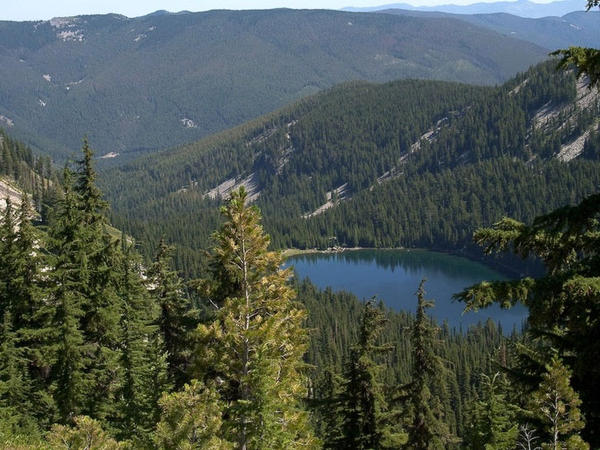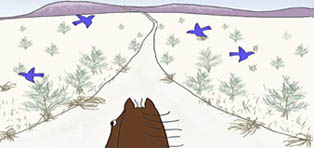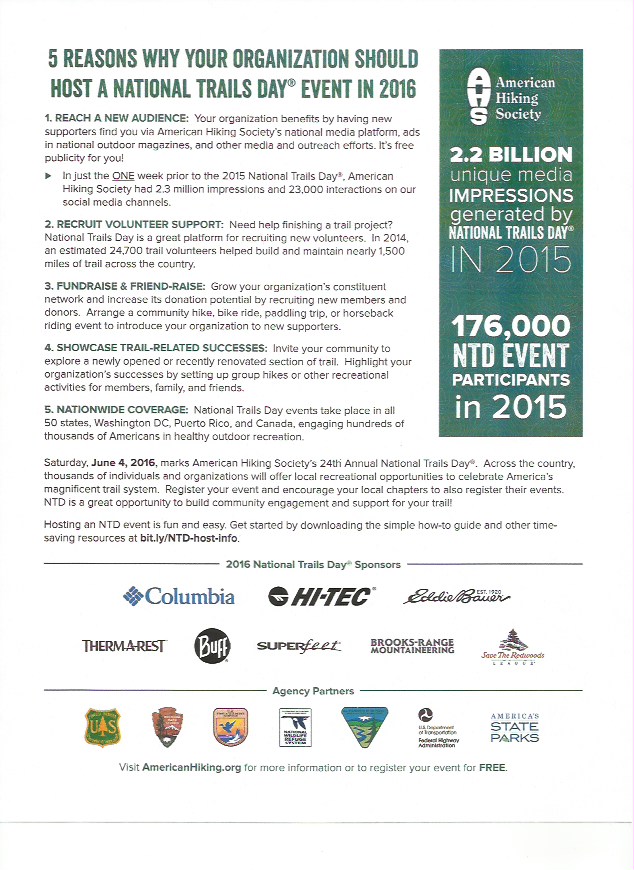February 17 2016
Did you know that in 2002 the National Park Service all but eliminated horseback use at Mount Rainier National Park, with the sole exceptions being the Pacific Crest Trail (PCT) and one feeder trail to the PCT? That decision represents an enormous bur under the saddle of horsemen, who have endured the near prohibition of pack and saddle stock in that park for nearly 14 years.
Yet today there is a golden opportunity to work with the Park Service in an effort to regain some of those trails. Mount Rainier National Park recently launched a public scoping process to support the development of a Wilderness Stewardship Plan. Importantly, the park's Superintendent appears open to revisiting the appropriate role of recreational stock use in Mount Rainier Wilderness.
Please consider submitting public scoping comments for the park's Wilderness Stewardship Plan by February 22nd, 2016 (details below). Your voice is needed to ensure that Mount Rainier Wilderness is again managed to be enjoyed by,and benefit from, recreational stock users like Back Country Horsemen who are committed to protecting and enhancing the park's wilderness character.
Background
The National Park Service is in the early phases of developing a 10- to 15-year management plan for Wilderness in Mount Rainier National Park. Located in Washington state's Cascades,
97% of Mount Rainier National Park was designated as Wilderness in 1988 in recognition of its outstanding resources and values.
The Mount Rainier Wilderness contains ancient forests, subalpine meadows, and the largest single-mountain glacial system in the contiguous 48 states. Mount Rainier provides visitors with diverse opportunities to experience the challenge and natural beauty of wilderness. A key objective of the plan is to "Develop an approach to managing visitor use such that wilderness character is preserved and public use and enjoyment are provided." We think that horsemen fit nicely into that vision.
Take Action
You can submit scoping comments by February 22nd via either U.S. Mail or through the Park Service's online planning portal, which is
here, then by clicking on the green "Comment Now" button. Mail can be sent to:
Randy King, Superintendent
Attn: Wilderness Stewardship Plan
Mount Rainier National Park
55210 238th Avenue East
Ashford, Washington 98304-9751
The park's online planning portal is easy to use. BCHA has included at the end of this Action Alert recommended talking points that you might consider adding among your personal comments. It's important to use your own words and add your own personal story among BCHA's suggested talking points.
Thank you for taking action to ensure renewed access and enjoyment of Mount Rainier Wilderness by pack and saddle stock users!
Donald Saner, Chairman
Back Country Horsemen of America
Recommended Talking Points
Feel free to enter your comments any way you choose. Remember, comments that are courteous and include examples and recommendations for improving wilderness management increase the chance that your comments will be greeted with receptivity.
• I am a stock owner and trail rider. I look forward to the day I can explore Mount Rainier Wilderness in the time-honored tradition of traveling with pack and saddle stock.
• I value the long-established tradition of use of pack and saddle stock in Mount Rainier National Park and throughout the West, and I wish to see this important historical use carried on into the future.
• I am dismayed by the Park Service's decision in 2002 to largely eliminate horse and pack stock use on nearly 100 miles of trail in the Mount Rainier Wilderness, as that decision did not appear to be supported by the necessary science.
• The current exclusion of horseback use on most of the park's Wilderness trails means that only the able-bodied are capable of immersing themselves in a Wilderness experience. For visitors that are either aged, mobility impaired, or otherwise unable to venture into park Wilderness on their own, the only opportunity to visit the park's Wilderness may be via horseback or mule.
• I place great value in the use of pack stock as a management tool that enables federal land management agencies to maintain and enhance wilderness character. For example, use of pack stock, a primitive mode of travel, in lieu of the use of helicopters for routine maintenance in Wilderness is one means by which the Park Service can maintain historic uses and achieve greater alignment with the agency's recently-adopted "Keeping it Wild" management philosophy.
• In order to reduce the potential for visitor conflict, the WSP should include proactive methods of visitor education, including the use of interpretive materials available at Wilderness trailheads, to convey to hikers and backpackers to expect encounters with persons using pack and saddle stock. The WSP also should detail methods by which visitors traveling via foot and with pack stock could enhance communication and work toward minimizing "conflict" between user groups. Changing the expectations of individuals prior to their embarking from the trailhead appears to represent a first step in doing so.
• Regulations proposed for use of pack stock should meet scientific rigor and necessity. The WSP must cite current peer-reviewed studies, and those studies must be made readily accessible for public review, if science is to be used to justify wide-range prohibitions or restrictions upon trail use or overnight camping.
• Science applied in the WSP must discern between the effects of pack stock use by private users versus the effects of the park's own administrative use of pack stock. In the absence of such science, the WSP should not seek to disproportionately burden private stock users, who would comprise only a small percentage of overnight Wilderness visitation.
• The WSP should include documentation of the preferences and desired experiences of recreational stock users, whose views might or might not align with views expressed by other Wilderness visitors as documented in existing social science literature.
• The WSP should consider, and make efforts to accommodate, the logistical needs of pack stock users who do not enter park Wilderness via adjacent national forests or private land. For example, the WSP should address the need for adequate trailer parking at park trailheads and designate specific front country camping areas for persons who haul their own horses and mules.
• Park personnel should work in partnership with Backcountry Horsemen of Washington (BCHW) to develop a park-wide equine Leave No Trace® (LNT) program that is included in the WSP. Park personnel and the WSP should consider entering into a formal partnership with BCHW for the development of a visitor education and LNT program for equine visitors to Mount Rainier National Park.
• The Park Service may soon find that it has insufficient resources to maintain trails in Mount Rainier Wilderness to standards that are necessary to maintain visitor safety and resource protection. Given that the WSP represents a long-range (10- to 15-year) plan, it would be prudent to consider in the WSP options for enlisting additional qualified partners in routine trail maintenance. For example, establishing formal agreements with qualified non-profit organizations, such as BCHW and its partner, the Pacific Crest Trail Association, would serve to augment the agency's beleaguered trail maintenance budget and could preclude the need to either close trails or reclassify some trails as either "unmaintained" or minimally maintained.
• Thank you for this opportunity to provide public scoping comments on the Mount Rainier Wilderness Stewardship Plan.
Back Country Horsemen of America | peg@bcha.org |
P.O. Box 1367
Graham, WA 98338
 NWPR.org - Full Article
NWPR.org - Full Article


 June 4, 2016 is American Hiking Society’s National Trails Day®, the country’s largest celebration of trails. National Trails Day events will take place in every state across the country and will include hikes, biking and horseback rides, paddling trips, birdwatching, geocaching, gear demonstrations, stewardship projects and more.
June 4, 2016 is American Hiking Society’s National Trails Day®, the country’s largest celebration of trails. National Trails Day events will take place in every state across the country and will include hikes, biking and horseback rides, paddling trips, birdwatching, geocaching, gear demonstrations, stewardship projects and more.